Popular categories
Looking for a yarn?
The yarn cost is calculated from the pattern’s smallest size and the yarn’s cheapest product type. Looking for an even better price? You might find it on the DROPS Deals!
Over Dover
Knitted vest in DROPS Air. The piece is worked bottom up with stocking stitch. Sizes S - XXXL.
DROPS Design: Pattern ai-419
Yarn group C or A + A
-------------------------------------------------------
SIZES:
S - M - L - XL - XXL - XXXL
MATERIALS:
DROPS AIR from Garnstudio (belongs to yarn group C)
200-250-250-300-300-350 g colour 03, pearl grey
NEEDLES:
DROPS CIRCULAR NEEDLE SIZE 5 MM: Length 80 cm.
DROPS CIRCULAR NEEDLE SIZE 4 MM: Length 40 cm and 80 cm.
The technique MAGIC LOOP can be used – you then only need circular needle of 80 cm in each size.
KNITTING TENSION:
17 stitches in width and 22 rows in height with stocking stitch = 10 x 10 cm.
NOTE: Needle size is only a guide. If you get too many stitches on 10 cm, change to a larger needle size. If you get too few stitches on 10 cm, change to a smaller needle size.
-------------------------------------------------------
Alternative Yarn – See how to change yarns here
Yarn Groups A to F – Use the same pattern and change the yarn here
Yarn usage using an alternative yarn – Use our yarn converter here
-------------------------------------------------------
The yarn cost is calculated from the pattern’s smallest size and the yarn’s cheapest product type. Looking for an even better price? You might find it on the DROPS Deals!
- English (UK/cm), Slovenia
- Česky
- Dansk
- Deutsch
- Eesti keel
- English (UK/cm)
- English (US/in)
- Español
- Français
- Íslenska
- Italiano
- Magyar
- Nederlands
- Norsk
- Polski
- Português
- Suomi
- Svenska
- English (UK/cm), Bulgaria
- English (UK/cm), Croatia
- English (UK/cm), Greece
- English (UK/cm), Latvia
- English (UK/cm), Lithuania
- English (UK/cm), Romania
- Česky, Slovakia
Pattern instructions
START THE PIECE HERE:
-------------------------------------------------------
VEST – SHORT OVERVIEW OF THE PIECE:
The piece is worked in the round with circular needle, bottom up as far as the armholes, then divided and the front and back pieces are finished separately, back and forth. The sleeve edges and neck are worked in the round with circular needle to finish.
BODY:
Cast on 182-198-214-232-250-278 stitches with circular needle size 4 mm and DROPS Air. Work rib in the round (knit 1, purl 1) for 6 cm. Knit 1 round and decrease 18-22-22-24-26-30 stitches evenly spaced = 164-176-192-208-224-248 stitches.
Change to needle size 5 mm and work stocking stitch until the piece measures 30-31-32-33-34-35 cm. Cast off for the armholes as follows: Knit 76-80-86-92-98-108, cast off 6-8-10-12-14-16 stitches, knit 76-80-86-92-98-108, cast off 6-8-10-12-14-16 stitches. Finish the back and front piece separately.
BACK PIECE:
= 76-80-86-92-98-108 stitches. Work stocking stitch back and forth and cast off for the armholes at the beginning of each row as follows: 2 stitches 1-1-2-2-3-4 times, 1 stitch 4-4-3-5-4-5 times on each side = 64-68-72-74-78-82 stitches. Now decrease for the diagonal shoulders and neck as described below.
DIAGONAL SHOULDERS:
When the piece measures 53-55-57-59-61-63 cm, place stitches on each side on a thread for the shoulders (to avoid cutting the strand, work them before placing them on the thread):
Place 5-6-6-6-7-8 stitches from the side 2 times, then place the last 8-8-9-10-9-9 stitches on the thread. When all the stitches are on threads place them back on circular needle size 5 mm and work one row over all stitches (to avoid holes in the transitions between stitches, pick up the strand between 2 stitches and work it twisted together with the next stitch on the left needle). Cast off on the next row.
NECK:
At the same time, when the piece measures 54-56-58-60-62-64 cm, cast off the middle 26-26-28-28-30-30 stitches for the neck and finish each shoulder separately. Cast off 1 stitch on the next row from the neck. When all the stitches are cast off the piece measures approx. 56-58-60-62-64-66 cm from the highest point on the shoulder. Repeat on the other shoulder.
FRONT PIECE:
= 76-80-86-92-98-108 stitches. Work stocking stitch back and forth and cast off for the armholes at the beginning of each row as follows: 2 stitches 1-1-2-2-3-4 times, 1 stitch 4-4-3-5-4-5 times on each side = 64-68-72-74-78-82 stitches.
When the piece measures 48-50-51-53-54-56 cm, place the middle 14-14-16-16-18-18 stitches on a thread for the neck and finish each shoulder separately.
Cast off stitches at the beginning of each row from the neck as follows: 3 stitches 1 time, 2 stitches 1 time and 1 stitch 2 times = 18-20-21-22-23-25 stitches.
DIAGONAL SHOULDERS:
When the piece measures 53-55-57-59-61-63 cm, place stitches on each side on threads for the shoulders in the same way as on the back piece. When all stitches are on threads place them back on circular needle size 5 mm and work one row over all stitches in the same way as on the back piece. Cast off on the next row.
The piece measures approx. 56-58-60-62-64-66 cm from the highest point on the shoulder. Repeat on the other shoulder.
ASSEMBLY:
Sew the shoulder seams.
NECK:
Start on one shoulder with short circular needle size 4 mm, knit up 68 to 82 stitches around the neck (including the stitches from the thread – stitch-number divisible by 2). Work rib in the round (knit 1, purl 1) for 3 cm. Cast off with knit over knit and purl over purl.
SLEEVE EDGES:
Start at the bottom of the armhole and knit up 78-82-86-88-92-96 stitches around the armhole with short circular needle size 4 - stitch-number divisible by 2. Work rib in the round (knit 1, purl 1) for 3 cm. Cast off with knit over knit and purl over purl. Work a similar edge around the other armhole.
This pattern has been corrected. Click here to see the correction/s.
BODY:...Change to needle size 5 mm and work stocking stitch until the piece measures 30-31-32-33-34-35 cm.
Diagram
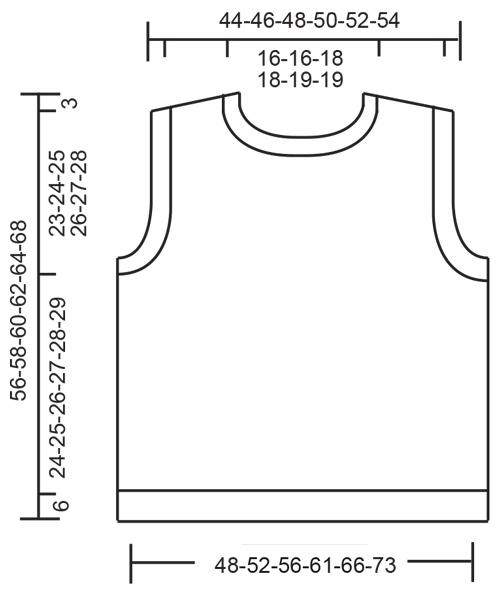
What can you do with our patterns? You can share DROPS patterns online, using the pattern original picture, materials, name and number. But you are NOT ALLOWED to reproduce the complete pattern digitally in any way. Yarn stores are welcome to use the DROPS pattern database to promote the sale of our assortment. You can print out our patterns, make as many copies as you’d like. The only thing we ask is that you don't make any changes / additions to the original printed document. And that the patterns according to the DROPS philosophy are given out to the consumers for free. Editorials that wish to publish our patterns in printed books or magazines can contact us for more information. The sale of garments based on DROPS patterns is permitted as long as they are sold as single items or per order. Further commercial use of the patterns is not permitted. It has to be clearly stated that the garment is made based on a design from DROPS DESIGN. The use of clothing labels of which DROPS DESIGN forms part is conditioned by the inclusion of the following text: “A DROPS DESIGN made by …..”. The use of DROPS photos for marketing purposes/sales is only permitted in connection with the use/sale of DROPS products. The photos may not be cut or edited and the logo should be clearly visible.
We reserve the right to withdraw the permission for use of our patterns at any time, notwithstanding the reason.
Each of our patterns has specific tutorial videos to help you.
These step-by-step tutorials might also help you:
Why is the knitting/crochet tension so important?
Knitting tension is what determines the final measurements of your work, and is usually measured per 10 x 10 cm. It is provided like so: number of stitches in width x number of rows in height - eg: 19 stitches x 26 rows = 10 x 10 cm.
The knitting tension is very individual; some people knit/crochet loosely while others work tightly. You adjust the knitting tension with the needle size, which is why the suggested needle size is only meant as a guide! You need to adjust this (up or down) to ensure that YOUR knitting tension matches the knitting tension provided in the pattern. If you work with a different knitting tension than provided you will have a different yarn consumption, and your work will have different measurements than what the pattern suggests.
The knitting tension also determines which yarns can replace each other. As long as you achieve the same knitting tension you can replace one yarn with another.
See DROPS lesson: How to measure your tension/gauge
See DROPS video: How to make a gauge tension swatch
How do I know how many balls of yarn I need?
The required amount of yarn is provided in grams, eg: 450 g. To calculate how many balls you’ll need you first need to know how many grams are in 1 ball (25g, 50g or 100g). This information is available if you click on the individual yarn quality on our pages. Divide the amount required with the amount of each ball. For example, if each ball is 50g (the most common amount), the calculation will be as follows: 450 / 50 = 9 balls.
Can I use a different yarn than what the pattern suggests?
The important thing when changing from one yarn to another is that the knitting/crochet tension remains the same. This is so that the measurements of the finished piece will be the same as on the sketch provided. It is easier to achieve the same knitting tension using yarns from the same yarn group. It is also possible to work with multiple strands of a thinner yarn to achieve the knitting tension of a thicker one. Please try our yarn converter. We recommend you to always work a test swatch.
Please NOTE: when changing yarn the garment might have a different look and feel to the garment in the photo, due to individual properties and qualities of each yarn.
See DROPS lesson: Can I use a different yarn than the one mentioned in the pattern?
What are the yarn groups?
All our yarns are categorised into yarn groups (from A to F) according to thickness and knitting tension – group A contains the thinnest yarns and group F the thickest. This makes it easier for you to find alternative yarns to our patterns, should you wish to switch yarn. All yarns within the same group have a similar knitting tension and can easily replace each other. However, different yarn qualities have different structures and properties which will give the finished work a unique look and feel.
How do I use the yarn calculator?
At the top of all our patterns you’ll find a link to our yarn calculator, which is a helpful tool should you wish to use a different yarn than suggested. By filling in the yarn quality you wish to replace, the amount (in your size) and number of strands, the calculator will present good alternative yarns with the same knitting tension. Additionally it will tell you how much you’ll require in the new qualities and whether you’ll need to work with multiple strands. Most skeins are 50g (some are 25g or 100g).
If the pattern is worked with multiple colours, every colour will have to be calculated separately. Similarly, if the pattern is worked with several strands of different yarns (for example 1 strand Alpaca and 1 strand Kid-Silk) you will have to find alternatives for each, individually.
Why do you show discontinued yarns in the patterns?
Since different yarns have different qualities and textures we have chosen to keep the original yarn in our patterns. However, you can easily find options among our available qualities by using our yarn calculator, or simply pick a yarn from the same yarn group.
It is possible that some retailers still have discontinued yarns in stock, or that someone has a few skeins at home that they would like to find patterns for.
The yarn calculator will provide both alternative yarn as well as required amount in the new quality.
What size should I knit?
If you think it's hard to decide what size to make, it can be a good idea to measure a garment you own already and like the size of. Then you can pick the size by comparing those measures with the ones available in the pattern's size chart.
You'll find the size chart at the bottom of the pattern.
See DROPS lesson: How to read size chart
Why do I get the wrong knitting tension with the suggested needle size?
The needle size provided in the pattern serves only as a guide, the important thing is to follow the knitting tension. And since knitting tension is very individual, you will have to adjust the needle size to ensure that YOUR tension is the same as in the pattern – maybe you’ll have to adjust 1, or even 2 needle sizes, up or down to achieve the correct tension. For this, we recommend that you work test swatches.
Should you work with a different knitting tension than the one provided, the measurements of the finished garment might deviate from the measurement sketch.
See DROPS lesson: How to measure your tension/gauge
See DROPS video: How to make a tension/gauge swatch
Why is the pattern worked top-down?
Working a garment top-down provides more flexibility and room for personal adjustment. For example it is easier to try the garment on while working, as well as making adjustments to length of yoke and shoulder caps.
The instructions are carefully explaining every step, in the correct order. Diagrams are adjusted to the knitting direction and are worked as usual.
How do I work according to a knitting diagram?
The diagram depicts all rows/rounds, and every stitch seen from the right side. It is read from bottom to top, from right to left. 1 square = 1 stitch.
When working back and forth, every other row is worked from the right side and every other row is worked from the wrong side. When working from the wrong side, the diagram will have to be worked reversed: from left to right, knit stitches are purled, purl stitches are knit etc.
When working in the round every round is worked from the right side and the diagram are worked from right to left on all rounds.
See DROPS lesson: How to read knitting diagrams
How do I work according to a crochet diagram?
The diagram depicts all rows/rounds, and every stitch seen from the right side. It is worked from bottom to top, from right to left.
When working back and forth every other row is worked from the right side: from right to left and every other row is worked from the wrong side: from left to right.
When working in the round, every row in the diagram are worked from the right side, from right to left.
When working a circular diagram you start in the middle and work your way outwards, counter clockwise, row by row.
The rows usually start with a given number of chain stitches (equivalent to the height of the following stitch), this will either be depicted in the diagram or explained in the pattern.
See DROPS lesson: How to read crochet diagrams
How do I work several diagrams simultaneously on the same row/round?
Instructions for working several diagrams after each other on the same row/round, will often be written like so: “work A.1, A.2, A.3 a total of 0-0-2-3-4 times". This means you work A.1 once, then A.2 is worked once, and A.3 is repeated (in width) the number of times provided for your size – in this case like so: S = 0 times, M = 0 times, L=2 times, XL= 3 times and XXL = 4 times.
The diagrams are worked as usual: begin with the first row in A.1, then work the first row in A.2 etc.
See DROPS lesson: How to read knitting diagrams
See DROPS lesson: How to read crochet diagrams
Why are the sleeves shorter in larger sizes?
The total width of the garment (from wrist-to-wrist) will be larger in the larger sizes, despite the actual sleeves being shorter. The larger sizes have longer sleeve caps and wider shoulders, so there will be a good fit in all sizes.
Where on the garment is the length measured?
The measurement sketch/schematic drawing provides information regarding the full length of the garment. If it’s a jumper or a jacket the length is measured from the highest point on the shoulder closest to the neckline, and straight down to the bottom of the garment. It is NOT measured from the tip of shoulder. Similarly, the length of yoke is measured from the highest point on the shoulder and down to where yoke is split into body and sleeves.
On a jacket measures are never taken along bands, unless specifically stated. Always measure inside band stitches when measuring the length.
See DROPS lesson: How to read a schematic drawing
What is a repeat?
Diagrams are often repeated on the round or in height. 1 repeat is the diagram the way it appears in the pattern. If it says to work 5 repeats of A.1 in the round, then you work A.1 a total of 5 times after/next to each other in the round. If it says to work 2 repeats of A.1 vertically/in height you work the entire diagram once, then begin again at the start and work the entire diagram one more time.
Why does the piece start with more chain stitches than it’s worked with?
Chain stitches are slightly narrower than other stitches and to avoid working the cast-on edge too tight, we simply chain more stitches to begin with. The stitch count will be adjusted on the following row to fit the pattern and measurement sketch.
Why increase before the rib edge when the piece is worked top-down?
The rib edge is more elastic and will contract slightly compared to, for example, stocking stitch. By increasing before the rib edge, you avoid a visible difference in width between the rib edge and the rest of the body.
Why increase in the cast-off edge?
It’s very easy to cast off too tightly, and by making yarn overs while casting off (and simultaneously casting these off) you avoid a too tight cast off edge.
See DROPS video: How to bind off with yarn overs (yo)
How do I increase/decrease on every 3rd and 4th row/round alternately?
To achieve an even increase (or decrease) you can increase on, for example: every 3rd and 4th row alternately, like so: work 2 rows and increase on the 3rd row, work 3 rows and increase on the 4th. Repeat this until the increase is complete.
See DROPS lesson: Increase or decrease 1 st on every 3rd and 4th row alternately
How can I work a jacket in the round instead of back and forth?
Should you prefer to work in the round instead of back and forth, you may of course adjust the pattern. You’ll need to add steeks mid-front (usually 5 stitches), and follow the instructions. When you would normally turn and work from the wrong side, simply work across the steek and continue in the round. At the end you’ll cut the piece open, pick up stitches to work bands, and cover the cut edges.
See DROPS video: How to knit steeks and cut open
Can I work a jumper back and forth instead of in the round?
Should you prefer to work back and forth instead of in the round, you may of course adjust the pattern so you work the pieces separately and then assemble them at the end. Divide the stitches for the body in 2, add 1 edge stitch in each side (for sewing) and work the front and back pieces separately.
See DROPS lesson: Can I adapt a pattern for circular needles into straight needles?
Why is the pattern slightly different than what I see in the photo?
Pattern repeats can vary slightly in the different sizes, in order to get the correct proportions. If you’re not working the exact same size as the garment in the photo, yours might deviate slightly. This has been carefully developed and adjusted so that the complete impression of the garment is the same in all sizes.
Make sure to follow instructions and diagrams for your size!
How do I make a women’s size garment into a men’s size one?
If you have found a pattern you like which is available in women’s size it’s not very difficult to convert it to men’s size. The biggest difference will be the length of sleeves and body. Start working on the women size that you think would fit across the chest. The additional length will be worked right before you cast off for the armhole/sleeve cap. If the pattern is worked top-down you can add the length right after the armhole or before the first decrease on sleeve.
Regarding additional yarn amount, this will depend on how much length you add, but it is better with a skein too many than too few.
How do I prevent a hairy garment from shedding?
All yarns will have excess fibres (from production) that might come off as lint or shedding. Brushed yarns (ie hairier yarns) have more of these loose, excess fibres, causing more shedding.
Shedding also depends on what is worn under or over the garment, and whether this pulls at the yarn fibres. It’s therefore not possible to guarantee that there will be no shedding
Below are some tips on how to get the best result when working with hairier yarns:
1. When the garment is finished (before you wash it) shake it vigorously so the looser hairs come off. NOTE: do NOT use a lint roller, brush or any method that pulls at the yarn.
2. Place the garment in a plastic bag and put it in your freezer - the temperature will cause the fibres to become less attached to each other, and excess fibres will come off easier.
3. Leave in the freezer for a few hours before taking it out and shaking it again.
4. Wash the garment according to the instructions on the yarn label.
Why does my garment pill?
Pilling is a natural process that happens to even the most exclusive of fibers. It's a natural sign of wear and tear that is hard to avoid, and that is most visible in high friction areas of your garment like a sweater's arms and cuffs.
You can make your garment look as new by removing the pilling, using a fabric comb or a pill/lint remover.
In the meantime, you can read the questions and answers that others have left to this pattern or join the DROPS Workshop on Facebook to get help from fellow knitters/crocheters!
You might also like...
Over Dover |
|
 |
 |
Knitted vest in DROPS Air. The piece is worked bottom up with stocking stitch. Sizes S - XXXL.
DROPS 235-17 |
|
|
------------------------------------------------------- START THE PIECE HERE: ------------------------------------------------------- VEST – SHORT OVERVIEW OF THE PIECE: The piece is worked in the round with circular needle, bottom up as far as the armholes, then divided and the front and back pieces are finished separately, back and forth. The sleeve edges and neck are worked in the round with circular needle to finish. BODY: Cast on 182-198-214-232-250-278 stitches with circular needle size 4 mm and DROPS Air. Work rib in the round (knit 1, purl 1) for 6 cm. Knit 1 round and decrease 18-22-22-24-26-30 stitches evenly spaced = 164-176-192-208-224-248 stitches. Change to needle size 5 mm and work stocking stitch until the piece measures 30-31-32-33-34-35 cm. Cast off for the armholes as follows: Knit 76-80-86-92-98-108, cast off 6-8-10-12-14-16 stitches, knit 76-80-86-92-98-108, cast off 6-8-10-12-14-16 stitches. Finish the back and front piece separately. BACK PIECE: = 76-80-86-92-98-108 stitches. Work stocking stitch back and forth and cast off for the armholes at the beginning of each row as follows: 2 stitches 1-1-2-2-3-4 times, 1 stitch 4-4-3-5-4-5 times on each side = 64-68-72-74-78-82 stitches. Now decrease for the diagonal shoulders and neck as described below. DIAGONAL SHOULDERS: When the piece measures 53-55-57-59-61-63 cm, place stitches on each side on a thread for the shoulders (to avoid cutting the strand, work them before placing them on the thread): Place 5-6-6-6-7-8 stitches from the side 2 times, then place the last 8-8-9-10-9-9 stitches on the thread. When all the stitches are on threads place them back on circular needle size 5 mm and work one row over all stitches (to avoid holes in the transitions between stitches, pick up the strand between 2 stitches and work it twisted together with the next stitch on the left needle). Cast off on the next row. NECK: At the same time, when the piece measures 54-56-58-60-62-64 cm, cast off the middle 26-26-28-28-30-30 stitches for the neck and finish each shoulder separately. Cast off 1 stitch on the next row from the neck. When all the stitches are cast off the piece measures approx. 56-58-60-62-64-66 cm from the highest point on the shoulder. Repeat on the other shoulder. FRONT PIECE: = 76-80-86-92-98-108 stitches. Work stocking stitch back and forth and cast off for the armholes at the beginning of each row as follows: 2 stitches 1-1-2-2-3-4 times, 1 stitch 4-4-3-5-4-5 times on each side = 64-68-72-74-78-82 stitches. When the piece measures 48-50-51-53-54-56 cm, place the middle 14-14-16-16-18-18 stitches on a thread for the neck and finish each shoulder separately. Cast off stitches at the beginning of each row from the neck as follows: 3 stitches 1 time, 2 stitches 1 time and 1 stitch 2 times = 18-20-21-22-23-25 stitches. DIAGONAL SHOULDERS: When the piece measures 53-55-57-59-61-63 cm, place stitches on each side on threads for the shoulders in the same way as on the back piece. When all stitches are on threads place them back on circular needle size 5 mm and work one row over all stitches in the same way as on the back piece. Cast off on the next row. The piece measures approx. 56-58-60-62-64-66 cm from the highest point on the shoulder. Repeat on the other shoulder. ASSEMBLY: Sew the shoulder seams. NECK: Start on one shoulder with short circular needle size 4 mm, knit up 68 to 82 stitches around the neck (including the stitches from the thread – stitch-number divisible by 2). Work rib in the round (knit 1, purl 1) for 3 cm. Cast off with knit over knit and purl over purl. SLEEVE EDGES: Start at the bottom of the armhole and knit up 78-82-86-88-92-96 stitches around the armhole with short circular needle size 4 - stitch-number divisible by 2. Work rib in the round (knit 1, purl 1) for 3 cm. Cast off with knit over knit and purl over purl. Work a similar edge around the other armhole. |
|

|
|
|
Have you made this or any other of our designs? Tag your pictures in social media with #dropsdesign so we can see them! Do you need help with this pattern?You'll find tutorial videos, a Comments/Questions area and more by visiting the pattern on garnstudio.com. © 1982-2024 DROPS Design A/S. We reserve all rights. This document, including all its sub-sections, has copyrights. Read more about what you can do with our patterns at the bottom of each pattern on our site. |
|
With over 40 years in knitting and crochet design, DROPS Design offers one of the most extensive collections of free patterns on the internet - translated to 17 languages. As of today we count 304 catalogues and 11422 patterns - 11422 of which are translated into English (UK/cm).
We work hard to bring you the best knitting and crochet have to offer, inspiration and advice as well as great quality yarns at incredible prices! Would you like to use our patterns for other than personal use? You can read what you are allowed to do in the Copyright text at the bottom of all our patterns. Happy crafting!







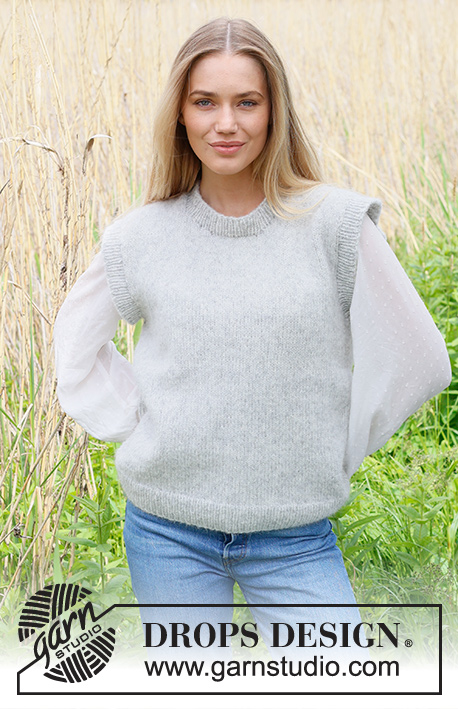

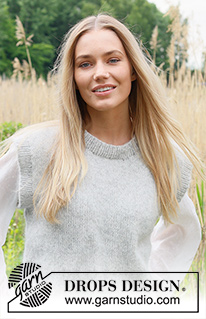
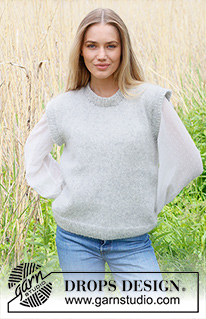








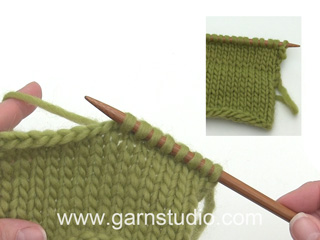








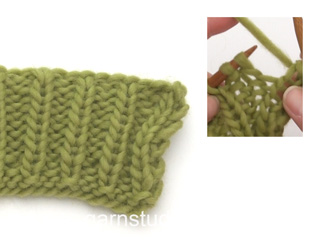

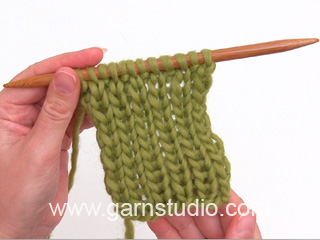































Comments / Questions (27)
Pattern Over Dover 235-17\r\nI am struggling to work out how to do the diagonal shoulders, particularly putting stitches on the threads in the side and how I interpret it doesn’t equate to the amount of stitches I have (working on the 3rd size (72 stitches). Please can someone provide a tutorial or explanation for very dense knitter? 🙏🏻
22.02.2023 - 19:55DROPS Design answered:
Dear Mrs Robertson, there are 21 stitches for each shoulder in size L, you will slip the stitches on a thread at the beginning of the rows starting from armhole: 6 sts 2 times + 9 sts 1 time (= 21 sts), then work all stitches back on needle and work them all then cast off on last row. At the same time, you will cast off for neck 28 sts + 1 st at the beg of each row from neck. This video shows (for another pattern) how to work diagonal shoulder and cast off for neck at the same time, hopefully it can help you. Happy knitting!
23.02.2023 - 13:36I have reached the part of the pattern explaining the DIAGONAL SHOULDERS but I’ve never done anything like this before and have no idea how to “place stitches on each side on a thread” as directed! I have tried to look for a relevant video to help me but cannot seem to find one… Any help much appreciated as I’ve ground to a halt!
21.02.2023 - 19:26DROPS Design answered:
Hello Beth! Here is the video: How to knit diagonal shoulders. Hope it helps!
22.02.2023 - 00:12Hej. Jeg strikker i str L, og jeg har lidt spørgsmål til den skrå skulder. Jeg har først sat 6 masker på tråd i hver side, og derefter 9 i hver side. Så har jeg 30 masker tilbage i midten. Er det rigtigt de skal blive på pinden? Der står når alle masker er på tråd? Hvordan kommer jeg videre, når de skal tilbage på pinden?
19.02.2023 - 21:31DROPS Design answered:
Hej Linda, du sætter 6+6+9 masker på en tråd i hver side. Når du har gjort det skal alle masker tilbage på pinden og så strikker du over alle masker igen :)
28.02.2023 - 15:19I have a query on the back neck (size S): after casting off the middle 26 sts, do I cast off 1 st at the neck edge only on the next 2 rows, or on every row on each shoulder side until all stitches have gone? Or should this have been done before casting off the shoulders? The diagram doesn’t show the difference between the front and back neck shaping.
08.02.2023 - 23:23DROPS Design answered:
Hi Maggie, No, you only cast off 1 stitch on each side of the neck. The side stitches are placed on threads little by little for the diagonal shoulders, then cast off as described in the text. Happy knitting!
09.02.2023 - 06:49Buonasera, prima di tutto mi scuso per le numerose domande, ma questo bellissimo modello proprio non riesco a capirlo. E non mi va di abbandonarlo … “CORPO: Finire il davanti e il dietro in modo separato” Inizio con il dietro (come scritto nel modello) … devo mettere in sospeso le maglie del davanti e lavorare solo sul dietro fino alla lunghezza indicata? Grazie mille Un caro saluto
05.02.2023 - 22:18DROPS Design answered:
Buonasera Sabina, esatto, prima procede lavorando il dietro e poi il davanti. Buon lavoro!
10.02.2023 - 16:06Buongiorno, mi sono fermata qui e non capisco come andare avanti. DIETRO: = 86 maglie. Lavorare in piano e intrecciare per gli scalfi all’inizio di ogni ferro come segue: 2 maglie 2 volte, 1 maglie 3 volte a ogni lato = 72 maglie. In particolare non capisco “ 1 maglie 3 volte a ogni lato” Grazie mille, Sabina :-)
04.02.2023 - 11:58DROPS Design answered:
Buonasera Sabina, in quel punto deve intrecciare 1 maglia all'inizio di ogni ferro a ogni lato per 3 volte, quindi 6 maglie intrecciate in tutto. Buon lavoro!
04.02.2023 - 22:44“Intrecciare per gli scalfi come segue: 86 maglie diritto, intrecciare 10 maglie, 86 maglie diritto, intrecciare 10maglie” Intreccio come se dovessi chiudere il lavoro? Grazie :-)
30.01.2023 - 00:38DROPS Design answered:
Buonasera Sabina, è corretto, deve chiudere le maglie. Buon lavoro!
01.02.2023 - 22:48Alla era mönster är verkligen fina. Problemet är -på i princip alla mönster- att beskrivningarna är rejält undermåliga. Emellanåt förstår man verkligen ingenting. Och på just det här mönstret kan man se på antalet kommentarer att beskrivningen brister. Jag har fått gissa och chansa på varje moment när jag kom till hals och axlarna. Västen är inte som den ska vara alls för att jag inte förstår och kan fylla i luckorna som uppenbarligen finns i beskrivningen
11.01.2023 - 19:37Kan jag sticka patent stickning istf slätstickning och hur påverkar det maskantal ? Strl L
07.12.2022 - 22:00DROPS Design answered:
Hei Marie. Du kan strikke den i patentstrikk, men vi har ikke anledning til å regne ut maskeantallet eller evnt forskjell på garnmengden. Men strikk en prøvelapp i patentstrikk og regn ut hva strikkefastheten du får vil være i forhold til strikkefastheten som er oppgitt i oppskriften. mvh DROPS Design
12.12.2022 - 10:56I am doing the second size- For the drop shoulders -I knit 6 then placed them on a holder- finished the row and turned- purled 6 and put them on a holder. I repeated this one more time. At that point there were 44 stitches. What does " then place the last 8-8-9-10-9-9 stitches on the thread" is that 8 stitches on each side? I tried that- but then after casting off the neck there is only one stitch left on each side. I went to my LYS but they did not know the answer either. .
19.11.2022 - 00:33DROPS Design answered:
Dear Lisa, that's correct, you place the last 8 stitches on each side. To get this specific shape for the neck and shoulders, you will cast off twice: first cast off the 26 middle stitches. Then, cast off the last stitch on each side. So 2 stitches remain after placing all stitches on the thread. Happy knitting!
21.11.2022 - 00:11